I had my first crackling fire in the fireplace last night. I was considering having it on the kitchen floor, but went with convention. And safety.
By tomorrow there could be a scorching heat wave with a humidex of bathhouse. You never can tell at this time of year. The weather's as unpredictable as the path of a butterfly. Or the success of a Will Smith movie.
Which makes cold frames a bit of a struggle because you have to actually pay attention to them. The beauty of the cold frame is that it's pseudo-gardening. There isn't a lot of work with them in the cold months. For the most part you just lift the lids and pick your lettuce or beets. But at this time of year you have to be reallyyyyy careful about making sure you vent them properly otherwise you'll end up with a big batch of cooked plants. So unless you plan on also throwing a glug of olive oil, salt, pepper and a toothpick into the frame, you have to make sure to keep an eye on the temperature in there.
For Spring and Fall plants like beets, carrots and lettuce the temperature inside the cold frame shouldn't get above 60 degrees. So if the temperature outside is 40 degrees, you need to vent your glass lights. If the temperature outside is about 50, you need to remove your glass lights. Put them back on once it's late afternoon and the sun isn't beating down on them. This will keep the frames warm throughout the evening and cooler night.
I planted 2 kinds of beets in August. Early Wonder beets which really did grow twice as fast as the other variety I planted.
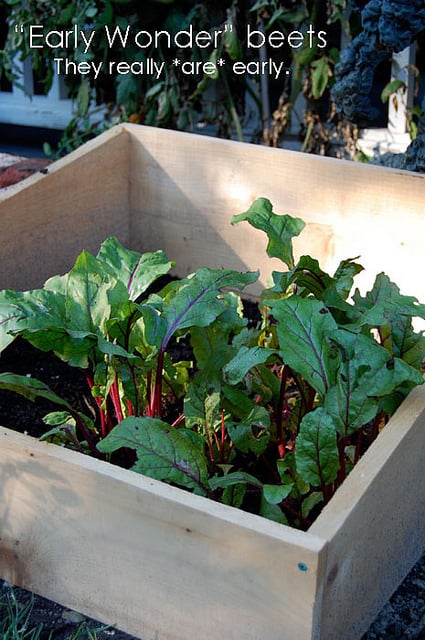
I also planted Cylindrical beets, which instead of growing round, grow more like a carrot, without the tapering at the end. So all of your beet slices will be the same size.
I also threw some carrots in there in August and low and behold they've been a success. A HUGE success. I'll bet 10 of the 742 carrots I planted grew. I really should write Mother Earth News about this carrot miracle.
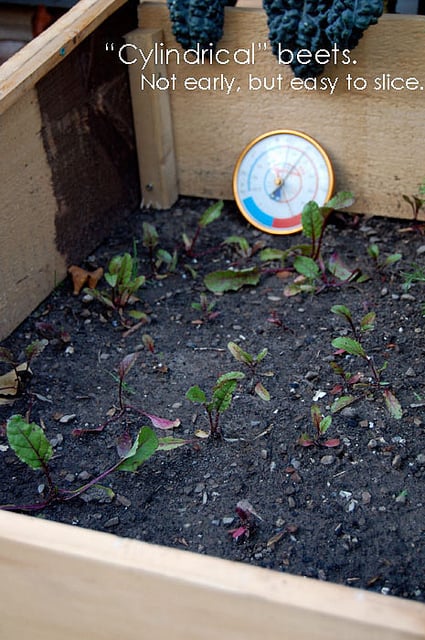
And then yesterday, I built another cold frame so I could plant greens. I ran out of wood so I scrounged around the house for anything I could build a square, 3 sided box out of. I came up with some very old bricks and an ugly storm window frame.
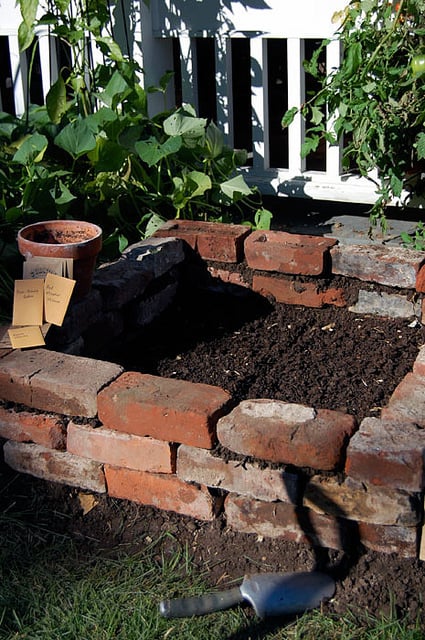
This frame isn't tilted like the other ones are, but since it's made out of brick it will hopefully retain heat a little bit better. This is all a crapshoot. I actually have no idea how any of these coldframes are going to do.
Laura, from Cubit's Organic Seeds sent me all the seeds one could ever need for planting fall and winter cold frame crops.
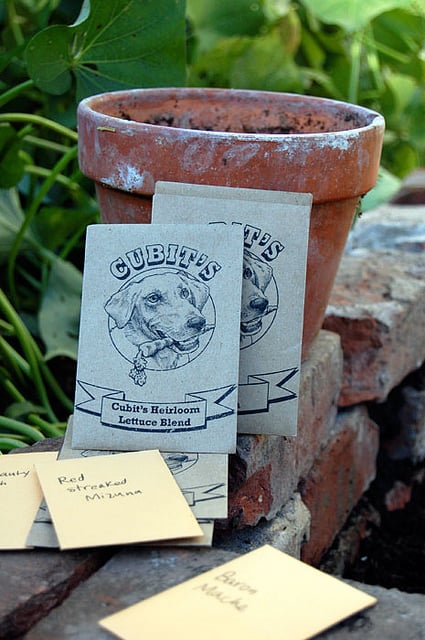
Would you like to save this stuff?
Anything you plant in a cold frame for fall growth takes much longer to grow because the conditions are cooler and there isn't as much sun. However, if you're going to grow greens in a cold frame, you're meant to harvest them when the leaves are only 3" or so high so you won't be waiting around for the plant to get to full mature size.
Mache is one of the best cold frame crops for this time of year. Lettuces grow well too and can actually freeze solid and still be fine to eat. You just have to wait until they've thawed out again (by late morning) before you harvest them. If you harvest them while frozen they'll turn to icky mush. But if you harvest them once they've naturally thawed they'll be beautiful, crisp, baby lettuce leaves. Even in January!
Baby greens seem to be able to withstand the freeze/thaw cycle but full sized plants do not.

I was on the ball enough in August to get a few carrots and beets into the ground but there's a lot more I could have planted if I'd had my act together.
At this time of year, if you do it *immediately* you can still be successful with several things in your cold frames. I say that with all the confidence of someone who has never done this.
Pay attention to your venting and you could be serving a baby green salad with radishes for your Christmas/Hannukah/Kwanza/end of December dinner.
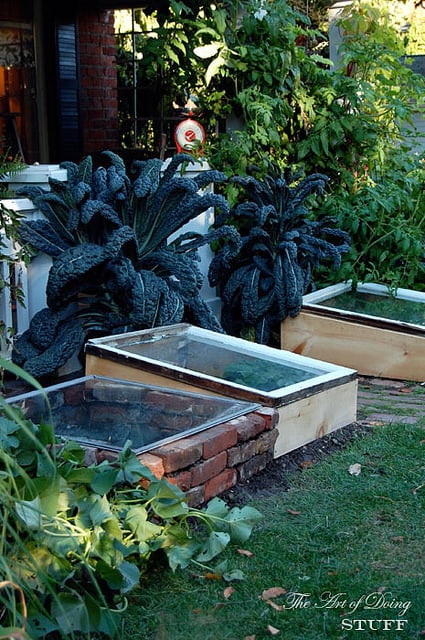
Don't pay attention to your venting and you could find yourself face down in the dirt gnawing away at your sautéed beet greens.

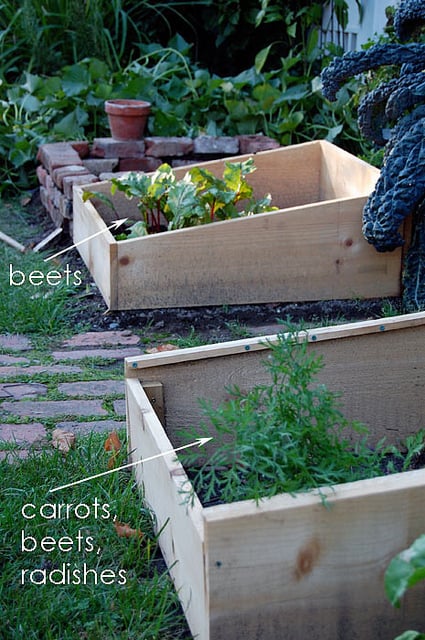
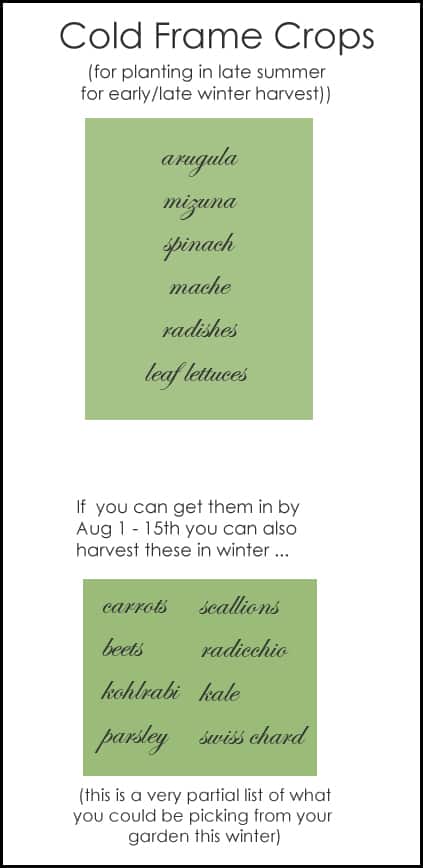


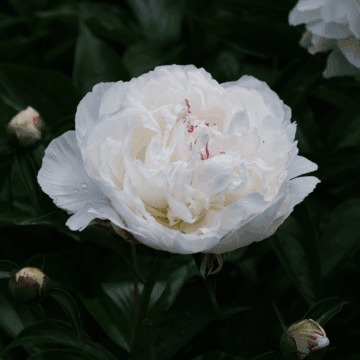

EyeCandyPopper
Now I'm gonna have to Google those F temperatures to figure out what it is in Celcius.....
On a serious note, how much sun are you supposed to get on these cold frames?
Erin
We use our cold frame to overwinter small salad greens. We've had good success with parsley, spinach and lettuce going into "suspended animation" overwinter and then giving us amazing greens very early in the spring while everything outside is still icy. The trick is keeping enough snow cover for insulation on the lights, but not too much that it breaks the glass.
I'm looking forward to seeing your cold frame garden develop, especially the mache. I keep reading about it but haven't grown it yet.
Beverly, zone 6 eastern PA
Remay is synthetic white floating row cover, similar to agribon I think. It reminds me of 7th grade home-ec class where we sewed with pellon, a stiff white spun-bond interfacing for collars, but remay is not that stiff. Remay has varying thickness = varying degrees of frost protection. When I wrap my basil,tomatoes or Colocasia in it overnight due to low temps, I must remember to remove it before the hottest part of the next day because it can "cook" what's inside. In winter, the remay stays on all the time because there is little danger of overheating the plants then. Twenty years ago I was given many yards for free at a Master Gardener gathering. I bought another long roll of it once since then. I still have all the pieces, a little raggedy, but quite usable.
Karen
Oh! LOL. I have scads of floating row cover. I had no idea it was called Remay! Thx. ~ karen!
Beverly, zone 6, eastern PA
I used reclaimed bricks in 4 raised beds here and there, small ones assembled to take advantage of the spaces available. They are very useful to keep our divine canine out of the food crops as she speeds around the yard. I also use other spare bricks for heat retention with wooden coldframes. The bricks keep the wood off the soil, preventing premature rotting and they absorb warmth during the daytime heating of the interior of the coldframe, radiating it back at night. It pays to assemble the bricks carefully to reduce drafts. When January and February are snow-less, I double wrap the entire body of the coldframe in remay. I have had lettuce crops go through the winter twice this way, eating fresh lettuce in March. I also place a woven copper wire barrier all around the inner perimeter to discourage slugs who will move in with luggage and set up a maternity ward because it's a warm place in winter.
Karen
Hi Beverly! My hope is the same for lettuce and radishes. I know the carrots and beets will survive because they survived last winter without any protection at all other than a tiny bit of straw. I have a question for you now ... what is remay? ~ karen!
Gertrude Wells
What is remay. yOUR IDEAS ARE GREAT. yOU MAY BE IN THE SAME TIME DONZE AS i AM IN. i'M LOOKING FOR IDEAS TO TRY.
tHANK YOU
tRUDY
Sue T.
Hi Karen, I am curious about how the plants are kept hydrated through-out the whole growing process. With the lights open and closed,changing temp's,getting covered with snow,etc...How do you regulate the moisture? What do you do if too much moisture builds up but it is way too cold to vent the boxes? Thanks.
Karen
I'll let you know when I find out Sue T. ... heh. Just kidding. Kind of. You water the plants when they need it. From what I can tell so far the lights do a good job of keeping even moisture in the frames even without watering. It's kind of like magic. ~ karen!
Barbie
I'm going to hold off on this cold frame thing of yours until I "see" what happens with yours....although I would have LOVED to have me some winter beets!! :( ANY beets....
Nancy Blue Moon
Yum..fresh salad for Christmas dinner would be awesome! Good luck girl..
Karen
Thank you ma'am! ~ karen
Kathy Hartzell
Lovely images and concept. You could make a recycled tire garden look smashing! My "new" greenhouse is still getting up to 100 in the day, with both vents operating and the door open, so I am totally in a quandary as to how to use it! It is at my sometimes house, so what I do there has to "survive" three nights without me...hence the thermo-vents, but solar screens and doors are dependent on me....so this experiment may be a failure til I live there FT...meanwhile, I need to rig up a screen for the roof and see if it will keep daytime temps to 80's or just use it to dry fruit!! BY THE WAY, it is all composed of recycled material except for the one sheet of plywood for sheer strength!!
Karen
Wow. Good job! I'm not sure where you are, but you could always just wait until slightly later in the season to plant in the greenhouse. ~ karen!
Rondina
We don't use cold frames in Texas. At least I've never seen one. I'm wondering if you have any ideas on how to save plants that MIGHT make it through the winter (lows can get down to 20 degrees F) if they only had some protection. There are a lot of "annuals" that are perennials elsewhere. If left in the ground some survive. I'm thinking about leaving everything in the ground this year and just planting other things between the plants and mulching over them. I'm sure folks have the same problem (different plants) else where and would like to hear any ideas you have or where to go for answers.
Karen
Rondina - A thick layer of straw can do wonders. Straw has miraculous insulating properties, because each stem of straw is filled with air. When I say thick, I mean about 2 feet thick. That's to be safe. Cover everything you want to save and hope for the best! (don't pack it down, cause that ruins the insulating properties and makes it more susceptible to staying wet) ~ karen
Pam'a
And there's nothing like asking someone locally who knows your particular climate. Look up your county extension website, or collar some old lady who has good garden juju. :)
Kelly
Question: I live in Atlanta, where it's late September (as it is everywhere), but it's still getting up into the 80s every day. Could I still plant beets and scallions? I'm thinking with the temperatures as they are, I'd probably have to wait a while before "putting the lights on" my cold frame anyway. Also--what about watering???
Karen
Kelly - The 80's is too warm for beets to germinate. They like the cooler weather. If you search, you may be able to find beets that have been bred to do better in warmer climates. Give that a shot! ~ karen
Feral Turtle
I love your reclaimed brick cold frame. That should be in a magazine!
Ruth
If you put small pieces of wood blocks under the edge of the windows, would that be enough 'venting'? Inquiring minds would like to know....
(I don't really need to do this right now, but you just never know where life will take me)
Karen
It depends on the temperature Ruth. The warmer it is out, the more venting you need. But most people use pieces of wood that have graduated notches in them so you can prop the light up on a notch. If the frame just barely needs venting, say in the winter, (canadian, not jamaican winter) then a small block would work fine. ~ karen!
Lynne
Can I just say - your kale looks spectacular!
Sandy
Thank you for this, Karen. I have a pile of old brick and an old greenhouse window. I am going to give this a try planting spinach.
Suanne
I like the look of the bricks much better than the wood frames. I know that makes little difference when you're most concerned about the way it would effect the growth, but I'm just sayin'. :)
Marti
This was very interesting. I always thought mache was something that, when moistened with potato paste, should be shaped into a lovely pinata.
I do see that your T-Rex kale is still profoundly productive. Will it survive the winter, too, or be killed by a meteor?
mimiindublin
Love the brick frame, it's a piece of art, no matter what happens inside it (I know I shouldn't have said that!)
Susan Dulley
Well, I won't be planting any Cold or Hot Frames this year, but, my father always did. Sounds like you are on the right track. Since I work at The Fresh Market, in Cincinnati, I really don't see the need to plant much anymore, however, I will always plant tomatoes, and herbs. Yes, the weather is a little radical at this time of year...45 degrees right now in Cinci, but, by noon it will be 75. Have a great day....off to the Market.
SpellingCow
This looks great! Did you just stack the bricks on top of each other? Maybe I could do the same for a raised herb/veg garden without the permanency of concrete. What do you think?
(PS is "sudo-gardening" an American term I don't know or do you mean "pseudo"? Sorry, I tried to restrain myself from asking, but I just can't help myself :( )
Karen
Oops, LOL. ~ karen
Amie Mason
This is really interesting to me. Living in Australia we don't have to worry about frost or snow - it's all about hydration and heat. Last summer was woeful. My strawberry crop was dead before Christmas. Tomatoes, zucchinis, cucumbers were pathetic. Anything that was in the sun died. So this year I'm going to adapt your method and make hot frames! I'm going to swap the glass for shade cloth and set up an automated watering system for early mornings and nights. Fingers crossed!